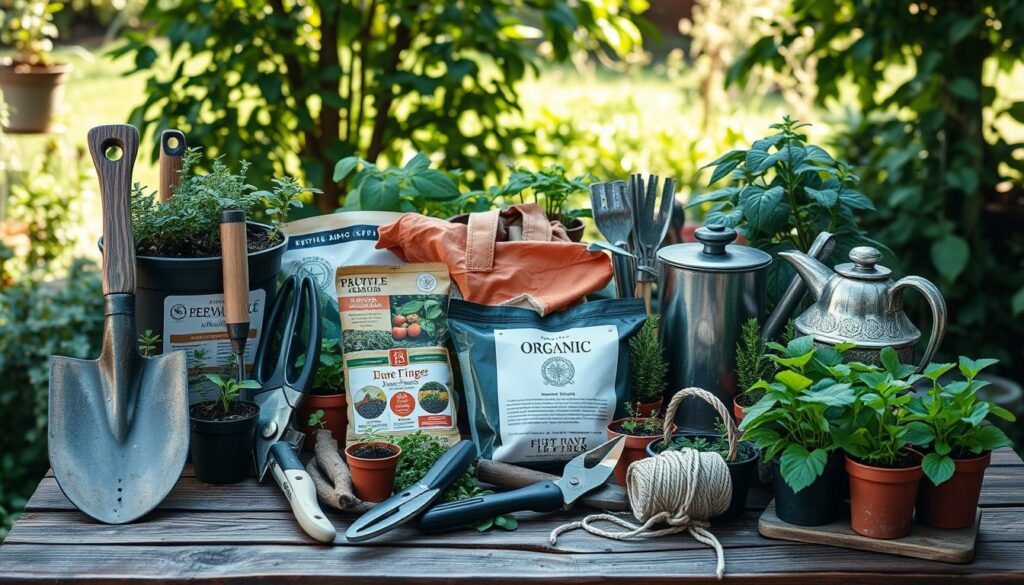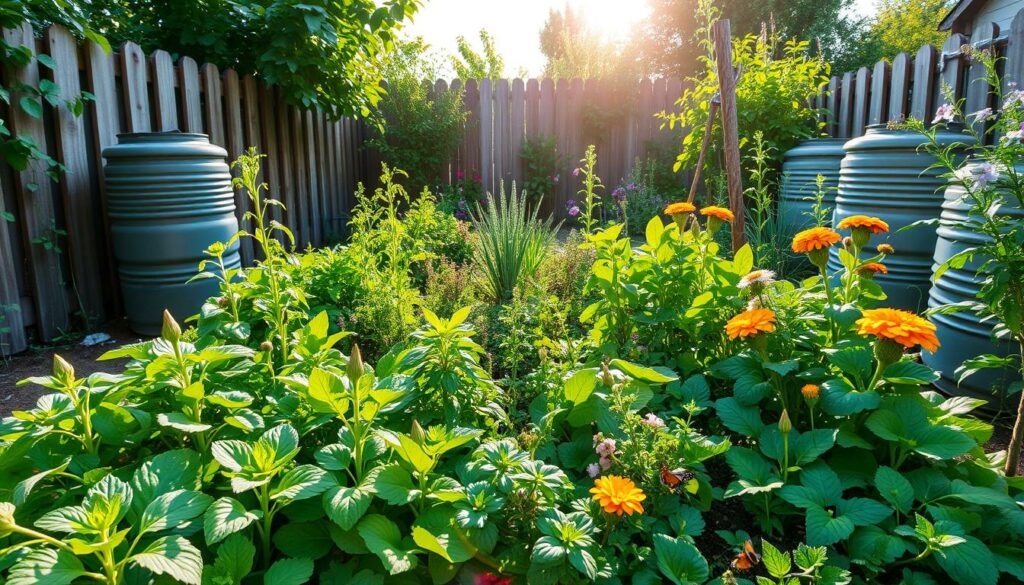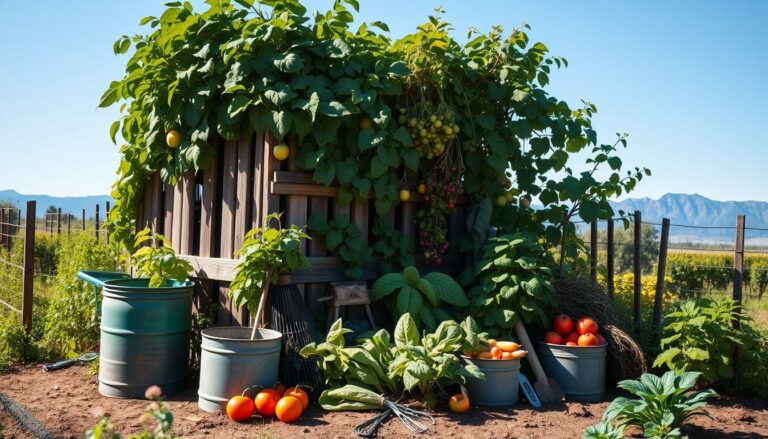When natural disasters or global crises hit, having a solid food security plan is key. Survival gardening is a practical and empowering way to grow your own food. It lets you cultivate nutritious food in your own backyard.
This shift from dependence to self-reliance brings peace of mind. You know you can produce your own food.
Survival gardens ensure a steady food supply in emergencies. They also help you live healthier and build a stronger community. Even a small 8’x4′ raised bed can yield a lot of food.
By growing your own food, you turn fear into action. You build resilience and self-sufficiency.
Learn the basics of survival gardening. Discover how simple steps can lead to lasting results.
Key Takeaways
- Survival gardening promotes food security during emergencies.
- Cultivating your own garden can provide nutritious, sustainable food options.
- One 8’x4′ raised bed can yield significant quantities of food.
- Transforming space into productive gardens builds resilience.
- Utilizing available resources efficiently is key to successful survival gardening.
Understanding the Importance of Survival Gardening
Creating a survival garden is key to keeping food on the table when stores run out. It’s more than just a backup plan; it’s a step towards living sustainably and being ready for emergencies. Growing your own food gives you control and boosts your resilience when times are tough.
A survival garden can greatly help with food self-sufficiency. For example, potatoes can yield 10 to 25 pounds for every pound planted. But, getting high yields requires a lot of work and the right conditions.
Woodland soil might only yield about 3 pounds per pound of potatoes. So, planting early is vital, as it takes months for crops to mature. Better soil can greatly increase these yields. For instance, adding compost to storage squash can lead to a big harvest without needing to change the soil everywhere.
Using cold-tolerant crops in containers as early as late spring is part of good emergency planning. Growing microgreens indoors all year gives a steady supply of fresh greens. These strategies ensure a constant flow of nutritious food, showing the value of self-sufficient gardening.
Yearly garden output is boosted by foraging, storing food, and preserving excess. Improving gardening skills, like container gardening and mushroom composting, shows the field’s growth.
| Aspect | Details |
|---|---|
| Yield | 10-25 pounds per pound of potatoes |
| Unimproved Soil Yield | 3 pounds per pound of potatoes |
| Cold-Tolerant Crops | Plant in late spring |
| Microgreens | Year-round indoor growth |
The World Bank says food security means having, affording, and keeping food available long-term. In survival gardening, choosing high-yield crops is critical. Using organic amendments like kelp meal and worm castings can greatly increase yields, helping families during emergencies.
An average family of four might need 0.25 to 2 acres for a survival garden. Given the average yard size in the USA is half an acre, using space wisely and effective gardening techniques are key. Choosing the right crops and planting them strategically can make a big difference in self-sufficiency.
In summary, survival gardening is vital for food security, making families self-sufficient and ready for emergencies. This empowering practice meets immediate needs and supports long-term sustainability and resilience.
How to Choose the Right Location for Your Garden
Finding the perfect spot for your survival garden is key for strong growth. The right location ensures the right sunlight and shade for your plants. This is vital for their health.
Vegetables need at least six hours of sunlight a day. But, 8-10 hours is best for them to grow well. Check the area during the day to see how much sun and shade it gets. Most veggies do well in full sun.
It’s important to pick a spot that’s easy to get to. You’ll need to water and harvest your plants often. Make sure to water in the morning. This lets the leaves dry off during the day, keeping diseases away.
Protect your garden from strong winds and heavy rain. You can use natural or man-made barriers to keep your plants safe. Also, avoid areas that collect cold air. This can harm your plants.
| Sunlight Exposure | Description |
|---|---|
| Full Sun | 8-12 hours of direct sunlight; ideal for most vegetables. |
| Part Shade | 4-6 hours of sunlight during the hottest part of the day. |
| Part Sun | 2-4 hours of direct morning or late afternoon sunlight. |
| Full Shade | No direct sunlight; only filtered to complete shade. |
What You’ll Need to Start Your Survival Garden
Starting a survival garden is rewarding. It gives you food security and self-sufficiency. To begin, you need the right Essential Tools and Supplies. This guide will help you get ready to grow your own food.

First, decide between seeds or young plants (starts). Each has its own benefits:
| Seeds | Starts | |
|---|---|---|
| Cost | Generally lower | Higher upfront cost |
| Variety | Wide selection | Limited choice |
| Growth Time | Longer germination period | Faster harvest |
After choosing, get your Essential Tools and Supplies. Here’s a list to start:
- Shovel and Spade: For digging and moving soil.
- Garden Hoe: Essential for weeding and cultivating soil.
- Rake: Useful for leveling soil and removing debris.
- Watering Can or Hose: To ensure consistent watering.
- Pruners: For trimming plants and harvesting produce.
- Garden Gloves: Protects your hands from soil and thorns.
The space needed for a survival garden varies. A family of four might need 0.25 to 2 acres. The right tools will help manage this space well.
Good crops for survival gardens include potatoes, legumes, corn, sweet potatoes, and winter squash. These provide lots of calories. Cold-hardy plants like kale and spinach can also extend the growing season.
Using space wisely is key. Triangular arrangements can yield 200-300 pounds of produce per 100 square feet. Gardening can also reduce your carbon footprint by 30%.
Getting kids involved in gardening is great. 90% of parents say it’s educational. It teaches kids about food and taking care of the environment.
In summary, with the right Essential Tools and Supplies, you’re ready to start a successful survival garden. It’s a great way to ensure food security and self-sufficiency.
Preparing Your Soil for Optimal Growth
Getting your soil right is key for a thriving survival garden. You need nutrient-rich soil for your plants to grow well. This can be achieved through double digging, composting, and using the right soil amendments.
Double digging loosens the soil to 18 to 22 inches deep. This lets roots grow deeper and improves air flow. It’s a deep process that makes the soil better but takes a lot of work. To fix compacted soil, mix 5 gallons of coarse sand with 10 gallons of compost.
Composting is vital for making soil rich in nutrients. Adding manure, food scraps, and yard waste boosts soil health. It takes about six months for compost to fully break down and enrich the soil. Keep organic matter levels between 4 to 8 percent for best results.
Soil testing is essential to know the pH and nutrient levels. Most plants prefer a pH between 6.0 and 7.5. Testing the soil helps you add lime or sulfur when needed. It also helps check if the soil drains well, preventing plant failure.
Here are some tips for mixing the right ingredients for different soil types:
| Soil Type | Ingredients |
|---|---|
| Ground with Sandy Dirt | 5 gal sandy dirt, 5 gal compost/manure, 1 cup 10-10-10 fertilizer |
| Ground with Hard Clay Dirt | 5 gal clay, 5 gal coarse sand, 10 gal compost/manure, 2 cups 10-10-10 fertilizer |
| Ground with Dark Moist Dirt | 5 gal coarse sand, 5 gal of your dirt, 1 cup 10-10-10 fertilizer |
| Ground with Compost | 5 gal coarse sand, 5 gal compost, 1 cup 10-10-10 fertilizer |
Good soil preparation gives your survival garden a strong start. It helps your plants grow well and gives you a bountiful harvest.
Selecting the Best Crops for a Survival Garden
Picking the right crops for a survival garden is key to having food when you need it most. A good garden should have crops that are full of nutrients, easy to keep, and useful for both food and medicine. Root vegetables, leafy greens, and herbs are the core of such a garden.
Root vegetables like potatoes, carrots, and turnips are vital. They keep well and give lots of energy. For example, potatoes can grow up to 2-3 pounds per plant, making them a great energy source.
Leafy greens, like kale and spinach, are also important. They can be picked over and over, giving you a steady flow of vitamins and minerals. Kale, for instance, can be picked for about six months, keeping you healthy all year.
Herbs for flavor and medicine are also key. Herbs like basil, mint, and oregano are great for cooking and have healing properties that are important in tough times.
Here’s a table that shows the main crops for a survival garden:
| Crop | Nutritional Value | Yields | Storage |
|---|---|---|---|
| Potatoes | High in carbohydrates | 2-3 pounds per plant | Several months |
| Kale | Rich in vitamins A, C, and K | Continuous harvesting | Short-term |
| Beans (Dry and Green) | 15-18 grams of protein per cup | Season-long harvest | Variable |
| Sweet Potatoes | Carbohydrates and vitamins | 5-10 tubers per plant | Several months |
| Tomatoes | Rich in vitamins C and K | 10-30 pounds per plant | Short-term |
These crops can grow in many climates and soils. Sweet potatoes do well in warm weather, while potatoes grow in cooler areas. Knowing the best growing conditions helps you get the most from your garden. This ensures you have enough food and nutrients to stay healthy during emergencies.
Building Raised Beds and Containers for Your Garden
Building raised beds and containers can change your garden. They make the most of your space and improve the soil. This guide will help you with the materials and tools you need. It also has a step-by-step guide to help you succeed in gardening.
Raised beds are popular because they are practical and last long. Some have lasted over 15 years. They are built with 2” x 12” redwood lumber, 10 feet long, 4 feet wide, and 24 inches high to keep gophers out.
- 6 dog-eared cedar fence posts
- 1 pressure-treated 2×2 (at least 4 feet long)
- 4×4 cedar or pressure-treated posts for corners (recommended for larger beds)
- 4 bags of 3 cubic feet of soil
- 1 bag of coarse sand (50 pounds)
- Gopher wire or hardware cloth
Raised beds offer many benefits:
- They reduce back strain, helping older gardeners or those with physical needs.
- They prevent gophers from tunneling, which can harm crops.
- They keep moisture in, which is good for seedlings, but can dry out faster than ground planting.
Here’s a comparison of typical raised bed dimensions and costs:
| Raised Bed Features | Details |
|---|---|
| Dimensions | 6 feet long x 18 inches wide x 11 inches high |
| Lumber Cost | Approximately $20 |
| Soil Cost | Approximately $35 |
| Total Investment | $55 |
To build your raised beds, cut 8 boards to 24” and 8 boards to 48”. Use 2 boards of 4×4, each 30” long. Also, use ¼” x ¼” galvanized steel fencing wire and 5 one-by-four boards for support. Add 2 bags of gardening soil to start with herbs and lettuce.
Use gopher wire or hardware cloth that goes 5 inches beyond the edges. You might also need a wool carpet or felt under the beds. This helps protect against tunneling pests. It can also improve yields and extend your garden’s life.
By 2024, we aim to use more organic potting mixes or alternatives for bed filling. Building these beds helps fight pests and makes gardening easier for everyone.
Maintaining Your Survival Garden Throughout the Seasons
Keeping your survival garden going all year needs regular care and smart planning. Using seasonal tips helps your plants do well, no matter the weather. Garden maintenance is key to keeping your garden productive, aiming for year-round gardening.
Start with daily watering, weeding, and checking for pests. Use organic pesticides to keep pests away without harming your plants. Mulch helps keep soil moist and controls temperature.
Knowing what your plants need helps them grow better. Plant cold-hardy veggies like turnips, carrots, broccoli, and cabbage every two weeks in spring. This way, you get a steady supply of fresh produce.
When it gets warmer, plant warm-weather crops like beans and corn from May to June. For longer-maturing crops, like beans for drying, start early to beat the frost.
- Early Spring: Start with cold-hardy crops.
- Late Spring: Transition to warm-weather plants.
- Summer: Keep watering and watch for pests.
- Fall: Harvest and get ready for next season.
- Winter: Use greenhouses or cold frames for protection.
Key structures like the Growing Dome protect against strong winds, heavy snow, and hail. They create a perfect spot for growing crops all year. These structures keep temperatures steady and extend the growing season.
Rotating crops is important for keeping soil healthy and preventing nutrient loss. It also helps avoid diseases and pests, keeping your garden healthy.
Test your soil regularly to ensure it’s right for your plants. Affordable tests can check nutrients and pH levels. This helps keep your soil balanced and healthy.
By sticking to these seasonal tips and regular garden care, you can have a constant supply of fresh food all year. This way, your survival garden stays productive, giving you the food you need in any emergency.
Harvesting and Storing Your Crops
Learning how to harvest and store your crops is key to getting the most from your garden. Knowing when and how to pick your fruits and veggies at the right time keeps them fresh and full of nutrients. Most crops should be picked in the morning when they’re at their peak.
Storing your crops right is also important. For example, potatoes and sweet potatoes can keep for a long time in a cool, dark spot. This helps you have healthy food even when it’s not growing season. Techniques like canning, freezing, and dehydrating are great for keeping food for a long time.
Here are some tips for best practices for harvesting and storing different types of produce:
- Tomatoes: Pick when they’re bright and slightly firm. Store them at room temperature, away from sunlight, to ripen fully.
- Root Vegetables: Wait until the leaves start to turn yellow. Cure them in a well-ventilated area before storing.
- Green Beans: Harvest when they snap easily. Blanch and freeze them for long-term storage.
- Herbs: Pick before they flower for the best taste. Dry or freeze them right away.
Choosing the right method for food preservation depends on the produce. Canning is great for tomatoes, green beans, and other veggies that keep their texture and taste. Freezing is best for berries and some leafy greens. Dehydrating is good for fruits like apples and pears, keeping them fresh for months without refrigeration.
Having a special place for storing food helps you keep track of what you have. This way, you can use the oldest items first, reducing waste. Good storage solutions are key to keeping food fresh and safe, ensuring you have a steady food supply all year.
In short, following these best practices for harvesting and storing can greatly improve your self-sufficiency and emergency preparedness. A little planning and effort can lead to a bountiful harvest, keeping you and your family well-fed all year.
Benefits of Self-Sufficient Gardening
Self-sufficient gardening offers more than just emergency preparedness. It boosts self-reliance by cutting down on commercial food needs, which is key during crises. For example, a few dollars’ worth of seeds can grow dozens of plants, feeding a family for many seasons.

The ecological benefits are huge. Perennials need little care and come back every year. Composting adds billions of good microbes to the soil, making it better. Chicken or livestock waste, rich in nitrogen, also improves compost.
Collecting rainwater saves water and cuts down on bills. It also gives plants clean, chemical-free water for growth.
For sustainable living, a good garden can produce a lot of food, up to 300 pounds a year. This can save $600 to $1,000 on grocery bills. Some foods, like sweet potatoes and winter squash, can last months without refrigeration.
| Produce | Caloric Value (per cup) | Storage Duration |
|---|---|---|
| Corn | 77 calories | Dry |
| Potatoes | 116 calories (cooked) | Months |
| Sweet Potatoes | 115 calories | Months |
| Beans (dried) | 200 calories | Dry |
| Pumpkin/Squash | 50-80 calories | 3-6 months |
Gardening meets nutritional needs with fresh, nutrient-rich food. Homegrown food is often 30% more nutritious than store-bought. The average American needs 1,600 to 3,000 calories a day, and a variety of garden crops can provide this.
Lastly, self-sufficient gardening is good for the planet by reducing waste. About 60% of gardeners eat what they grow, cutting down on food waste. Smart garden planning can double productivity, showing it’s both cost-effective and eco-friendly.
Community and Resources for Survival Gardening
Being part of a gardening community is key to success in survival gardening. Urban families and individuals can greatly benefit from joining local gardening clubs. These clubs offer hands-on learning, helping you tackle pests, weeds, and soil issues. They also host seed swaps, which are vital during times like the Covid-19 pandemic.
Online forums are another great source of support. They let gardeners of all levels share tips and solutions. By joining, you get practical advice for your area, helping you understand germination and crop maturation. This builds both knowledge and community spirit.
Workshops and webinars are also essential for improving your gardening skills. Workshops teach you how to compost, which boosts soil fertility. Webinars cover budget-friendly strategies, from basic tools and seeds to more significant investments. These sessions aim to equip you with the skills for self-sufficiency, ensuring your garden meets most of your family’s food needs in emergencies.
Source Links
- https://www.hachettebookgroup.com/titles/sam-coffman/survival-gardening/9781635866469/
- https://growfully.com/emergency-vegetable-garden/
- https://practicalselfreliance.com/survival-garden/
- https://www.revivalgardening.com/post/survival-garden?srsltid=AfmBOore1saU6JLGgbNBQxVPQGLeo5hJAGO7gfLJAPoIMDFGZTanff-j
- https://sebsnjaesnews.rutgers.edu/2020/04/choosing-the-right-location-for-your-vegetable-garden/
- https://www.chelseagreen.com/2024/7-factors-to-consider-when-choosing-a-planting-site/?srsltid=AfmBOoqcYGUPae59faRdtpDW-2X7fOFNJSaGLTGeIC9EIQdzw9vnJAuV
- https://gardenerspath.com/plants/vegetables/grow-survival-garden/
- https://www.gardenersbasics.com/tools/blog/survival-garden?srsltid=AfmBOopysbuwSTQUWQxwPNb0HwpH93_H5owDuGo-iXSNa7-4eWL7JSIz
- https://www.revivalgardening.com/post/survival-garden?srsltid=AfmBOorxTNgvkZMoDIpSten5QMH2IK5BlxY3dT-bsnqGwUK9QHhY0FNf
- https://soiltesting.cahnr.uconn.edu/preparing-new-garden-beds/
- https://www.instructables.com/Make-Garden-Soil-from-any-Dirt/
- https://survivalgardenseeds.com/pages/survival-garden-growing-guide-preparing?srsltid=AfmBOoocjLuwfLPTaFgTKQMAeNUw6Q7K0I8cTxFkKGYIAHkilicp6MGH
- https://www.epicgardening.com/survival-garden/
- https://theprepared.com/homestead/guides/best-garden-crops/
- https://the-compulsive-gardener.com/2021/02/01/how-to-build-a-raised-garden-bed-for-growing-vegetables-with-gopher-protection/
- https://gardenerspath.com/how-to/hacks/build-diy-raised-beds/
- https://www.instructables.com/Elevated-Garden-Planter/
- https://growingspaces.com/survival-garden/
- https://www.new-terra-natural-food.com/four-season-survival-garden.html
- https://valleyfoodstorage.com/blogs/inside-vfs/survival-garden-seeds-layout-planning-survivalist-garden?srsltid=AfmBOoovUXjzWsbEutmzMIBTkMVQiqjcpI5B6Uewsgt06E_84Sh4QTMm
- https://survivalgardenseeds.com/pages/survival-garden-growing-guide-preparing?srsltid=AfmBOorgboFdwKn_mCY_DFT35Rew_Mh51a_EZuzGOyJ1JnLBQajfNJ5u
- https://survivalgardenseeds.com/blogs/survival-garden-training/the-law-of-the-harvest-survival-gardening?srsltid=AfmBOorlR3Wjn8YB3HrgpP_sUoAwLZHBaShqP-ltfwXl0qUEikl3DrgU
- https://www.gardenersbasics.com/tools/blog/survival-garden?srsltid=AfmBOoofTTWcN9GZ22xR-360G6JaJ01nVVfkqnFnYI8ak9JJi5ajtwJl
- https://growinginthegarden.com/self-sufficient-gardening/
- https://www.attainable-sustainable.net/survival-garden/
- https://gardening.org/growing-a-garden-for-survival-plants/
- https://theprepared.com/homestead/guides/gardening/
- https://melissaknorris.com/podcast/survival-garden/

